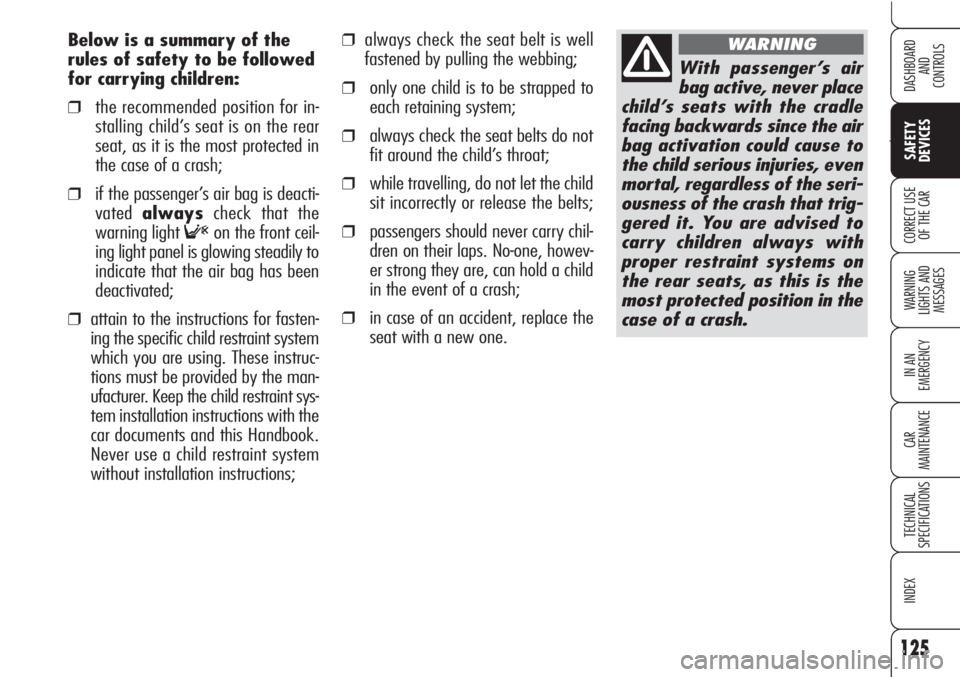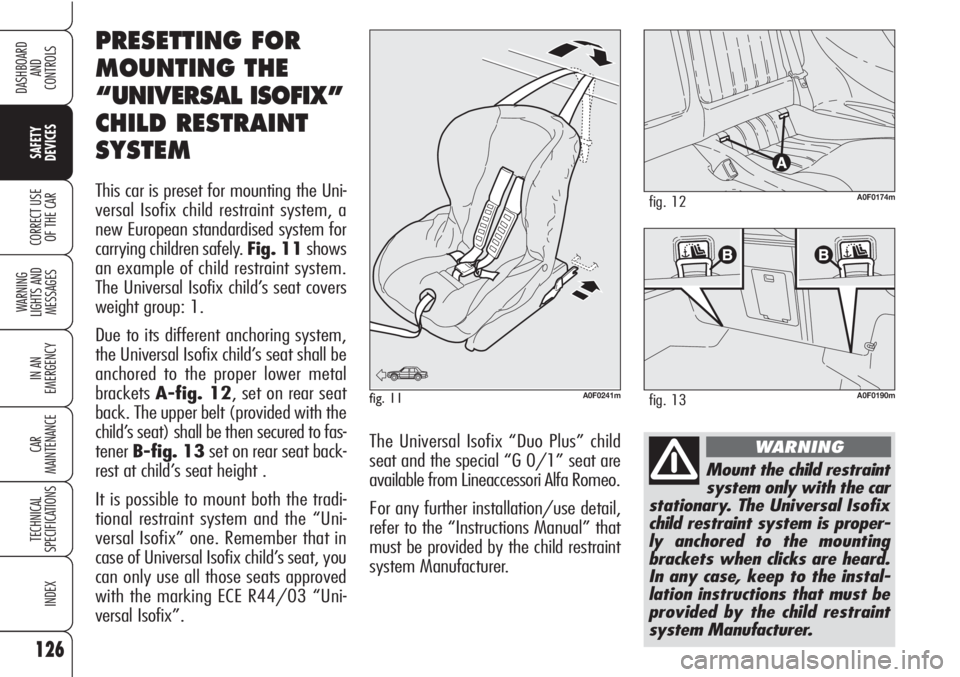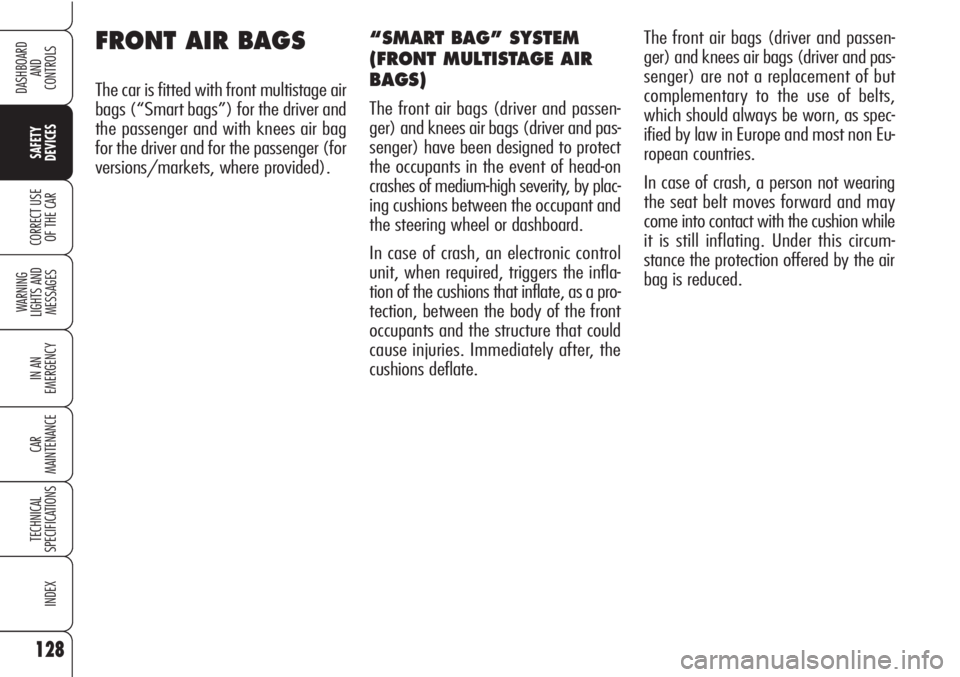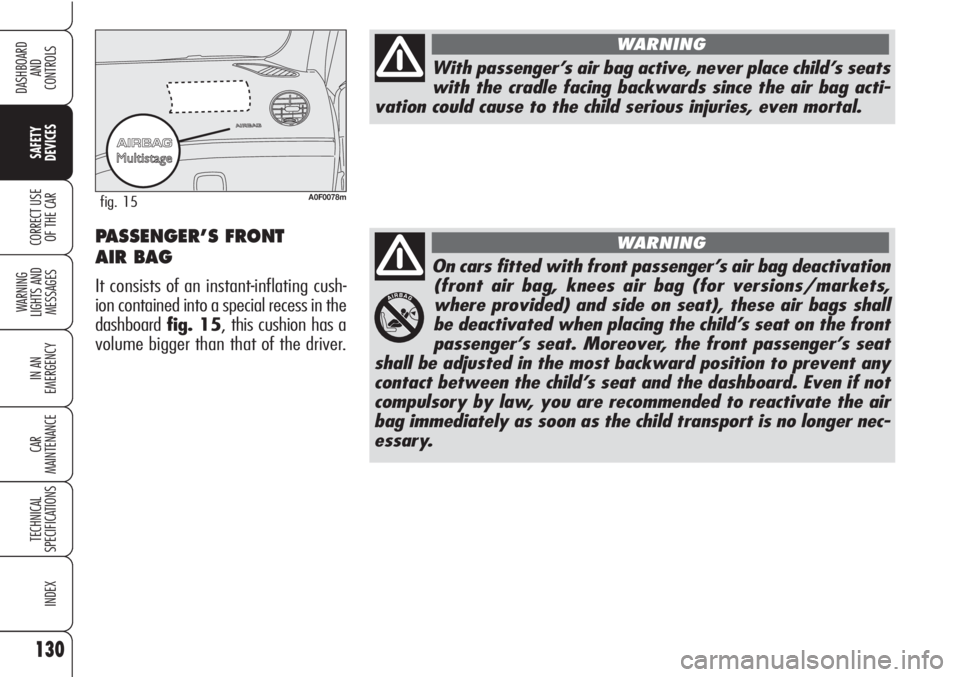Page 125 of 271
123
Ù
SAFETY
DEVICES
WARNING
LIGHTS AND
MESSAGES
IN AN
EMERGENCY
CAR
MAINTENANCE
TECHNICAL
SPECIFICATIONS
INDEX
DASHBOARD
AND
CONTROLS
CORRECT USE
OF THE CARGROUP 2
Starting from 15 kg to 25 kg in weight,
children may be restrained directly by
the car belts. The only function of the
seat is to position the child correctly in
relation to the belts, so that the diago-
nal part adheres to the chest and not
to the neck and that the horizontal part
clings to the child’s pelvis and not the
abdomenfig. 9.
GROUP 3
For children between 22 kg and 36 kg,
there are boosters allowing the seatbelt
to fit correctly. Fig. 10shows proper
child seat positioning on the rear seat.
Children taller than 1.50 m can wear
seat belts like adults.
A0F0108mfig. 9A0F0109mfig. 10
The illustrations are in-
dicative only for as-
sembly. Assemble the seat ac-
cording to the compulsory in-
structions provided with it.
WARNING
Page 126 of 271
124
SAFETY
DEVICES
WARNING
LIGHTS AND
MESSAGES
IN AN
EMERGENCY
CAR
MAINTENANCE
TECHNICAL
SPECIFICATIONS
INDEX
DASHBOARD
AND
CONTROLS
CORRECT USE
OF THE CAR
SUITABILITY OF PASSENGER SEATS FOR CHILD SEAT USE
Your car complies with the new European Directive 2000/3/EC regulating child’s seat assembling on the different car seats
according to the following tables:
Front and rear seat
SEAT
Group Range of weight Front Rear side
Seat with Seat with Rear
4 positions 8 positions passenger
Group 0, 0+ up to 13 kg U (*) U (*) U
Group 1 9-18 kg U (*) U (*) U
Group 2 15-25 kg U (*) U (*) U
Group 3 22-36 kg U (*) U (*) U
Key:
U= suitable for child restraint systems of the “Universal” category, according to European Standard EEC-R44 for the specified “Groups”.
(*) = on cars not fitted with passenger’s seat adjustable in height, the seat back shall be positioned perfectly upright. On cars fitted with
passenger’s seat adjustable in height, the seat shall be raised as much as possible.
Page 127 of 271

125
Ù
SAFETY
DEVICES
WARNING
LIGHTS AND
MESSAGES
IN AN
EMERGENCY
CAR
MAINTENANCE
TECHNICAL
SPECIFICATIONS
INDEX
DASHBOARD
AND
CONTROLS
CORRECT USE
OF THE CAR
❒always check the seat belt is well
fastened by pulling the webbing;
❒only one child is to be strapped to
each retaining system;
❒always check the seat belts do not
fit around the child’s throat;
❒while travelling, do not let the child
sit incorrectly or release the belts;
❒passengers should never carry chil-
dren on their laps. No-one, howev-
er strong they are, can hold a child
in the event of a crash;
❒in case of an accident, replace the
seat with a new one. Below is a summary of the
rules of safety to be followed
for carrying children:
❒the recommended position for in-
stalling child’s seat is on the rear
seat, as it is the most protected in
the case of a crash;
❒if the passenger’s air bag is deacti-
vatedalwayscheck that the
warning light
Fon the front ceil-
ing light panel is glowing steadily to
indicate that the air bag has been
deactivated;
❒attain to the instructions for fasten-
ing the specific child restraint system
which you are using. These instruc-
tions must be provided by the man-
ufacturer. Keep the child restraint sys-
tem installation instructions with the
car documents and this Handbook.
Never use a child restraint system
without installation instructions;
With passenger’s air
bag active, never place
child’s seats with the cradle
facing backwards since the air
bag activation could cause to
the child serious injuries, even
mortal, regardless of the seri-
ousness of the crash that trig-
gered it. You are advised to
carry children always with
proper restraint systems on
the rear seats, as this is the
most protected position in the
case of a crash.
WARNING
Page 128 of 271

126
SAFETY
DEVICES
WARNING
LIGHTS AND
MESSAGES
IN AN
EMERGENCY
CAR
MAINTENANCE
TECHNICAL
SPECIFICATIONS
INDEX
DASHBOARD
AND
CONTROLS
CORRECT USE
OF THE CAR
Mount the child restraint
system only with the car
stationary. The Universal Isofix
child restraint system is proper-
ly anchored to the mounting
brackets when clicks are heard.
In any case, keep to the instal-
lation instructions that must be
provided by the child restraint
system Manufacturer.
WARNING
PRESETTING FOR
MOUNTING THE
“UNIVERSAL ISOFIX”
CHILD RESTRAINT
SYSTEM
This car is preset for mounting the Uni-
versal Isofix child restraint system, a
new European standardised system for
carrying children safely. Fig. 11shows
an example of child restraint system.
The Universal Isofix child’s seat covers
weight group: 1.
Due to its different anchoring system,
the Universal Isofix child’s seat shall be
anchored to the proper lower metal
bracketsA-fig. 12, set on rear seat
back. The upper belt (provided with the
child’s seat) shall be then secured to fas-
tenerB-fig. 13set on rear seat back-
rest at child’s seat height .
It is possible to mount both the tradi-
tional restraint system and the “Uni-
versal Isofix” one. Remember that in
case of Universal Isofix child’s seat, you
can only use all those seats approved
with the marking ECE R44/03 “Uni-
versal Isofix”.The Universal Isofix “Duo Plus” child
seat and the special “G 0/1” seat are
available from Lineaccessori Alfa Romeo.
For any further installation/use detail,
refer to the “Instructions Manual” that
must be provided by the child restraint
system Manufacturer.A0F0174mfig. 12
fig. 11A0F0241mA0F0190mfig. 13
Page 129 of 271
Range of weight Child’s seat Isofix size Isofix position
direction group side rear
Group 1 from
9 to 18 kg
127
Ù
SAFETY
DEVICES
WARNING
LIGHTS AND
MESSAGES
IN AN
EMERGENCY
CAR
MAINTENANCE
TECHNICAL
SPECIFICATIONS
INDEX
DASHBOARD
AND
CONTROLS
CORRECT USE
OF THE CAR
IUF: suitable for Isofix child restraint systems to be set facing forwards, universal class (fitted with third upper fastener), approved for
the weight group.
PASSENGER SEAT COMPLIANCE WITH REGULATIONS ON ISOFIX CHILD’S SEAT USE
The table below, according to ECE 16 European Directive, shows the different installation possibilities of Isofix restraint sys-
tems on seats fitted with Isofix fasteners.
B
B1
AIUF
IUF
IUF Facing forwards
Facing forwards
Facing forwards
Page 130 of 271

128
SAFETY
DEVICES
WARNING
LIGHTS AND
MESSAGES
IN AN
EMERGENCY
CAR
MAINTENANCE
TECHNICAL
SPECIFICATIONS
INDEX
DASHBOARD
AND
CONTROLS
CORRECT USE
OF THE CAR
FRONT AIR BAGS
The car is fitted with front multistage air
bags (“Smart bags”) for the driver and
the passenger and with knees air bag
for the driver and for the passenger (for
versions/markets, where provided).The front air bags (driver and passen-
ger) and knees air bags (driver and pas-
senger) are not a replacement of but
complementary to the use of belts,
which should always be worn, as spec-
ified by law in Europe and most non Eu-
ropean countries.
In case of crash, a person not wearing
the seat belt moves forward and may
come into contact with the cushion while
it is still inflating. Under this circum-
stance the protection offered by the air
bag is reduced.
“SMART BAG” SYSTEM
(FRONT MULTISTAGE AIR
BAGS)
The front air bags (driver and passen-
ger) and knees air bags (driver and pas-
senger) have been designed to protect
the occupants in the event of head-on
crashes of medium-high severity, by plac-
ing cushions between the occupant and
the steering wheel or dashboard.
In case of crash, an electronic control
unit, when required, triggers the infla-
tion of the cushions that inflate, as a pro-
tection, between the body of the front
occupants and the structure that could
cause injuries. Immediately after, the
cushions deflate.
Page 131 of 271

129
Ù
SAFETY
DEVICES
WARNING
LIGHTS AND
MESSAGES
IN AN
EMERGENCY
CAR
MAINTENANCE
TECHNICAL
SPECIFICATIONS
INDEX
DASHBOARD
AND
CONTROLS
CORRECT USE
OF THE CARDRIVER’S FRONT AIR BAG
It consists of an instant-inflating cushion
contained in a special recess in the cen-
tre of the steering wheelfig. 14. Front air bags may not be activated in
the following situations:
❒front collisions against highly de-
formable objects not affecting the
car front surface (e.g. bumper colli-
sion against guard rail, etc.);
❒in case of wedging under other ve-
hicles or protective barriers (for ex-
ample under a truck or guard rail);
❒the air bag is not triggered as it offers
no additional protection compared
with the seat belts, consequently it
would be pointless. Therefore, failure
to come into action in the above cir-
cumstance does not mean that the
system is not working properly.
Do not apply stickers
or other objects to the
steering wheel or to the air
bag cover on the passenger’s
side or on the side roof lining.
Never put objects (e.g. mobile
phones) on the dashboard on
passenger side since they
could interfere with proper
passenger air bag inflation and
also cause serious injury.
WARNING
A0F0077mfig. 14
Page 132 of 271

130
SAFETY
DEVICES
WARNING
LIGHTS AND
MESSAGES
IN AN
EMERGENCY
CAR
MAINTENANCE
TECHNICAL
SPECIFICATIONS
INDEX
DASHBOARD
AND
CONTROLS
CORRECT USE
OF THE CAR
On cars fitted with front passenger’s air bag deactivation
(front air bag, knees air bag (for versions/markets,
where provided) and side on seat), these air bags shall
be deactivated when placing the child’s seat on the front
passenger’s seat. Moreover, the front passenger’s seat
shall be adjusted in the most backward position to prevent any
contact between the child’s seat and the dashboard. Even if not
compulsory by law, you are recommended to reactivate the air
bag immediately as soon as the child transport is no longer nec-
essary.
A0F0078mfig. 15
With passenger’s air bag active, never place child’s seats
with the cradle facing backwards since the air bag acti-
vation could cause to the child serious injuries, even mortal.
WARNING
WARNINGPASSENGER’S FRONT
AIR BAG
It consists of an instant-inflating cush-
ion contained into a special recess in the
dashboardfig. 15, this cushion has a
volume bigger than that of the driver.